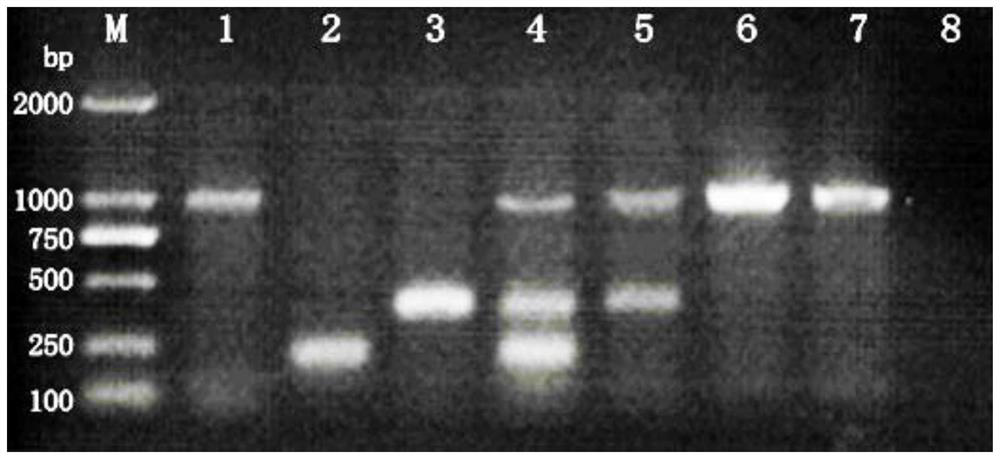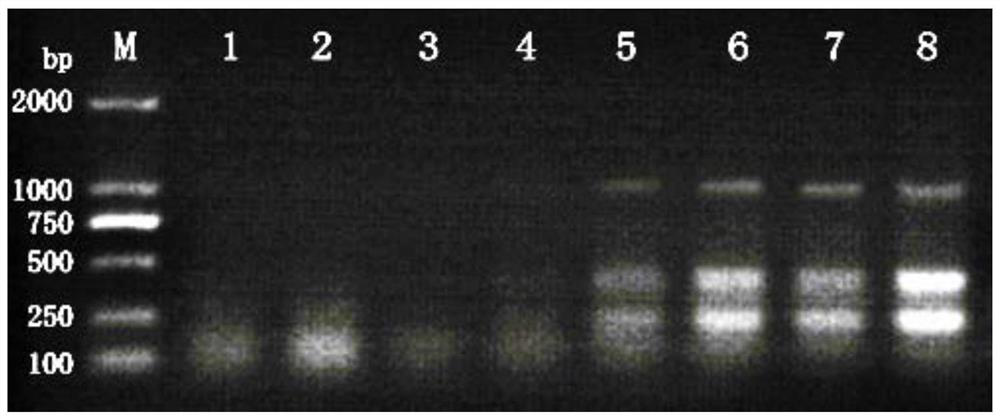A triple PCR detection primer and kit for rapidly distinguishing African swine fever virus wild strains from gene-deleted strains
An African swine fever virus and gene deletion technology, applied in the field of virus strain identification, can solve the problems of cumbersome steps, unfavorable rapid identification and the like
- Summary
- Abstract
- Description
- Claims
- Application Information
AI Technical Summary
Problems solved by technology
Method used
Image
Examples
Embodiment 1
[0037] Example 1 Primer Design
[0038]The inventor compared a large number of CD2V, P72, 360-505R genes of African swine fever virus (ASFV) published in the GenBanK database of NCBI (National Center for Biological Information), which are highly conserved and have specific regions, designed as ASFVCD2V, P72, 360 The -505R gene is a pair of specific primers, respectively named as P1, P2, P3, P4, P5, and P6, thereby providing a PCR primer for distinguishing ASFV wild-type strains and gene-deleted strains, specifically:
[0039] P1: ASFV-P72-F: 5'AACCAGTGGCCCTCTCCTAT 3' (SEQ ID NO: 1);
[0040] P2: ASFV-P72-R: 5'AATCGCATTGCCTCCGTAGT 3' (SEQ ID NO: 2);
[0041] P3: ASFV-CD2V-F: 5' TCCTAAGCCTTACAGTCGTTATCAGT 3' (SEQ ID NO: 3);
[0042] P4: ASFV-CD2V-R: 5'AGATAATGGCGGGATATTGGGTAGT 3' (SEQ ID NO: 4);
[0043] P5: ASFV-360-505R-F: 5' TCTTGTCCTTTTCATACGCCTCAT 3' (SEQ ID NO: 5);
[0044] P6: ASFV-360-505R-R: 5'GAGCACACCTGGGACCTCT 3' (SEQ ID NO: 6).
[0045] P1 and P2 are used to am...
Embodiment 2 3
[0048] Embodiment 2 Triple PCR detection method
[0049] Materials and Methods
[0050] 1.1 Primers in Example 1
[0051] 1.2 Sample DNA extraction
[0052] There are no special requirements for DNA extraction, which can be extracted according to conventional methods or DNA extraction kits. The extracted DNA was stored at -20°C for later use or immediately used for PCR amplification.
[0053] 1.3 Positive plasmid
[0054] Using the partial gene sequences of ASFV CD2V, P72, and 360-505R published in the GenBanK database to artificially synthesize the gene, connect it to the pJET1.2 cloning vector, transform Escherichia coli competent cell DH5α, and spread it on LB containing 100mg / L ampicillin On the culture medium plate, culture at 37°C for 12-16 hours. After the bacteria were picked, screened and identified by sequencing, the positive bacteria were expanded and cultured, and the plasmids were extracted. The positive plasmids were named pJET-P72, pJET-CD2V and pJET-360-505...
Embodiment 3
[0067] Embodiment 3 specificity test
[0068] According to the triple PCR detection method established in 1.4 in Example 2, pair 1: wild strain without gene deletion; 2: deletion of CD2V strain; 3: deletion of CD2V and 360-505R strain; 4: positive plasmid (P72); 5: negative Control (DEPC water); 6: classical swine fever virus (CSFV); 7: porcine pseudorabies virus (PRV); 8: porcine reproductive and respiratory syndrome virus (PRRSV); 9: porcine parvovirus (PPV); 10: Porcine encephalitis virus (JEV); 11: rotavirus (RV); 12: porcine epidemic diarrhea virus (PEDV); 13: porcine deltacoronavirus (PDCoV), for detection. The results are attached figure 2 shown.
[0069] From attached figure 2 As can be seen in the figure, corresponding to 1: wild strain without gene deletion; 2: deletion of CD2V strain; 3: deletion of CD2V and 360-505R strain; 4: positive plasmid (P72) in the corresponding fragment size. See clear bands, while negative control (DEPC water); 6: classical swine fe...
PUM
| Property | Measurement | Unit |
|---|---|---|
| diameter | aaaaa | aaaaa |
Abstract
Description
Claims
Application Information
 Login to View More
Login to View More - R&D
- Intellectual Property
- Life Sciences
- Materials
- Tech Scout
- Unparalleled Data Quality
- Higher Quality Content
- 60% Fewer Hallucinations
Browse by: Latest US Patents, China's latest patents, Technical Efficacy Thesaurus, Application Domain, Technology Topic, Popular Technical Reports.
© 2025 PatSnap. All rights reserved.Legal|Privacy policy|Modern Slavery Act Transparency Statement|Sitemap|About US| Contact US: help@patsnap.com



